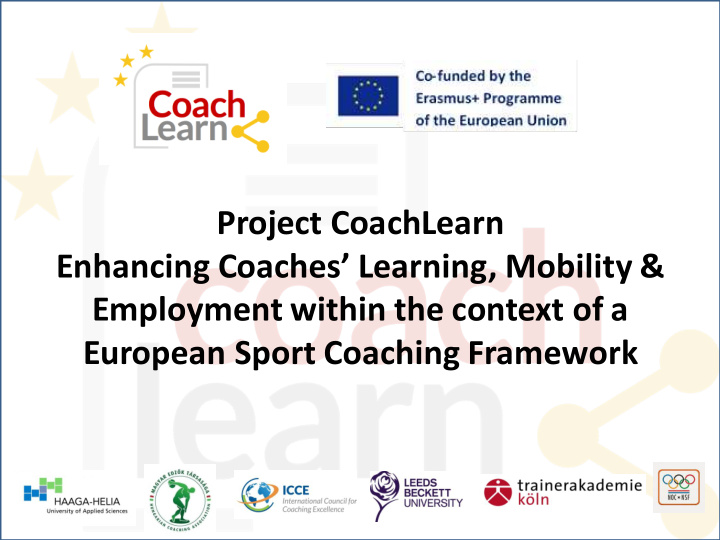



Project CoachLearn Enhancing Coaches’ Learning, Mobility & Employment within the context of a European Sport Coaching Framework
Chapter 6 – Coach Certification & Recognition Step by step guide to recognition of prior learning/work based experience and coach assessment Kirsi Hämäläinen, Finnish Olympic Committee Jan Minkhorst, Netherlands Olympic Committee
CoachLearn http://www.coachlearn.eu/project- objectives.html Already published: • Report #1 Qualifications Frameworks and Employment and Mobility Tools in the European Union - March 2016 • Report #2 Recognition of Prior Learning and Work-Based Experience in Coach Development • Report #3 Sport Coaching Workforce Data Collection in 5 Countries
Idea To make a tool that helps a coach education organization to build a system for RPL and WBE.
What are your needs as an organization regarding to RPL 1) Map generally the way coach-education is organized in your country a. Which different institutes/organizations are involved (federations; VET-studies; Universities etc.) a. Which frameworks are used as a reference point (National Sport coaching framework; National Qualification Framework; EQF) a. The background of your students entering a study on coach education i. From “outside” (no Coach education) ii. ii. between the different institutes/organizations with coach education in the map 2. Appoint your own institute in the map 3. Try to determine the amount of students entering your studies both outside and from other Coach educating institutes. 4. Appoint where RPL-systems already exist 5. Appoint where RPL-systems non-exist but are probably useful
Coach education (big picture) X NQF EQF 3 1 2 6 2 3 Y 1 2 3 Z Figure 1: X, Y, Z: Educational organizations using different Qualification structures/frameworks on sports Education. NQF: National Qualification Framework EQF: European Qualification Framework
Coach education (big picture) X NSCF NQF EQF 1 4 2 5 2 4 Y 6 1 2 4 Z Figure 2: X, Y, Z: Educational organizations using different Qualification structures/frameworks on sports Education. NSCF: National Sport Coaching Framework NQF: National Qualification Framework EQF: European Qualification Framework
Coach Education and RPL in the Netherlands X NSCF NQF EQF F N 1 E 4 O D 5 C 2 * N F S E 2 4 Y F D 6 V 1 2 4 E T Z figure. 3 : The Netherlands
Coach Education and RPL in Belgium (Flanders) X NSCF NQF EQF 1 V T 4 V S 2 5 K S F E Y D 6 figure. 4 : Belgium (Flanders)
Figure 1. Phases of RPL system building for the coach education organization
Figure 2. The phases of RPL for Coach Developer
Figure 3. RPL process for the coach
Assessment • Criteria for the assessment method: – validity: the tool must measure what it is intended to measure; – reliability: the extent to which identical results would be achieved every time a candidate is assessed under the same conditions; – fairness: the extent to which an assessment decision is free from bias (context dependency, culture and assessor bias); – cognitive range: does the tool enable assessors to judge the breadth and depth of the candidate’s learning; – fitness for purpose of the assessment: ensuringthe purpose of the assessment tool matches the use for which it is intended. – safety, security and confidentiality: is the candidate protectedfrom abuse duringthe process? – standards/referential: are the benchmarks of content and level of learningwell defined? – sustainability: will the process operate over time within resources of the money and time required? – visibility/transparency: is the process of validation generally understoodand does it lead to wider recognition of the candidate’s learning? – cost-efficiency: can the process be modified so that the benefits (personal and financial) are in proportion to the cost? (European guidelines for validatingnon-formal and informal learning 2009)
Assessment methods • debate: offers the candidate an opportunity to demonstrate depth of knowledge as well as communicative skills • declarative methods: based on individuals ’ own identification and recording of their competences, normally signed by a third party, to verify the self-assessment • interviews can be used to clarify issues raised in documentary evidence presented and/or to review scope and depth of learning • observation: extracting evidence of competence from an individual while they are performing everyday tasks at work • portfolio method: using a mix of methods and instruments employed in consecutive stages to produce a coherent set of documents or work samples showing an individual’s skills and competences in different ways.
Figure 4. Building an individual learning path when the curriculum contains courses and modules.
Questions raising … from Finnish workshop • How to make a system that is simple enough? • Workload (organizations): Could there be a crieteria for entering RPL system? • Easier if the modules or courses are large enough • How to make it work in a project based curriculum? • Biggest issue are univerisity students entering federations education and vice versa
Other questions? • What other concerns there are? • What other tools are needed? • Good solutions?
Recommend
More recommend